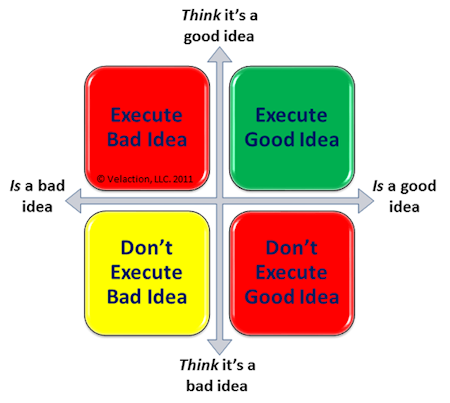How Do YOU Approach An Idea?
There are two basic types of people. Those who are worried about trying an idea that won’t work, and those that are worried about not trying an idea that might work.
The first type can go a whole career with some degree of success. Every time I play golf, I realize that at my skill level, a successful game is far more about avoiding errors than it is about making great shots. When I hit a great drive down the middle of the fairway, it rarely translates into a birdie (one better than par). But when I hit a shot into the water, or lose one in the woods, or misread a green, the extra shots pile on in a hurry. I find that being risk averse results in better scores for me.
But in real life off the golf course, I am more worried about missing opportunities than I am about making mistakes. There is a lot of competition in the improvement consulting world. Simply avoiding mistakes is not enough to be successful. You end up being left behind by others with more interesting, effective training tools and more innovative ideas. You have to take chances and try new things to keep your rivals from pulling ahead of you.
If you are familiar with sampling or hypothesis testing, you will recognize what I am talking about: error types. You might know them as Type-I and Type-II, or alpha and beta errors. One is the “false positive”, in which something is thought to be true, but really isn’t. And the other is the “false negative”. In that error mode, a rejected hypothesis is, in fact, true.
The same thought process applies to idea generation. In the chart below, you can see this graphically. Every idea is either good or bad, but it is also perceived as good or bad. Arranging the two parameters into a grid gives four quadrants.

So, as you can see by the color coding, only one of these quadrants is good. Obviously, acting on a good idea is a positive thing. And just as obvious, the two failure modes I touched on earlier are problems.
So what happens is that people develop a personal bias towards either being more aggressive with implementing ideas, resulting in more false positives, or they refrain from acting, resulting in more false negatives.
Those who aggressively pursue good ideas will end up with some mistakes, but will also frequently find themselves squarely in the green.
Those who work to avoid mistakes usually accomplish that, and spend a lot of time in the bottom left quadrant, avoiding bad ideas.
The lower left quadrant is yellow because it is mostly neutral. The business doesn’t get hurt, but there is also no gain to not implementing a bad idea. You simply stay where you are. But there is a side effect of trying so hard to avoid bad ideas. People also leave a lot of good ideas on the table, never to be acted on.
What if the iPod had been one of those ideas? Or penicillin? Or vaccinations? Or mobile phones? All of those were risky ideas that could easily have ended up as false negatives.
The literally million dollar question here is to figure out which matters more in your business. Are you better off avoiding mistakes, or capitalizing on opportunities? The truth is that you want both, but the reality of life is that personalities and company cultures will always lean in one direction or the other.
So, the next time you dismiss something as a bad idea, think about whether the idea really is awful, or if you are simply hunkering down in the lower left quadrant where you can safely ride out the possibility of an error. Then ask yourself what the upside is if you take a chance on the idea and it pans out. I am not advocating throwing caution to the wind. I am just saying that if you want to be a great golfer, it is not simply enough to stay out of the woods. Sometimes you have to push yourself a little outside of your comfort zone and try to clear a water hazard or bunker if you want to get a truly great score.



0 Comments